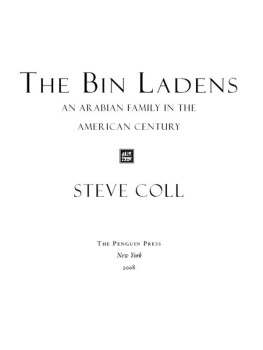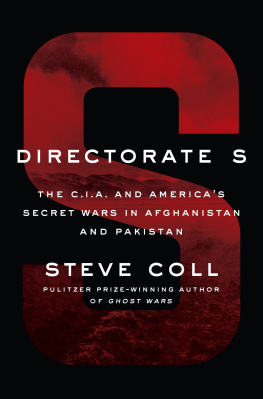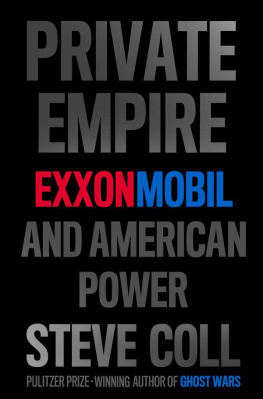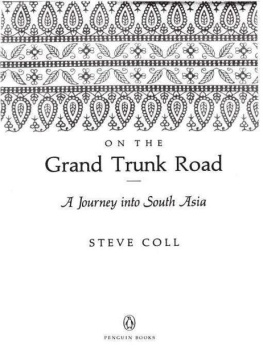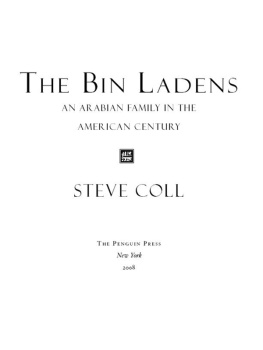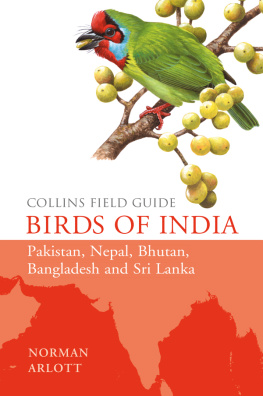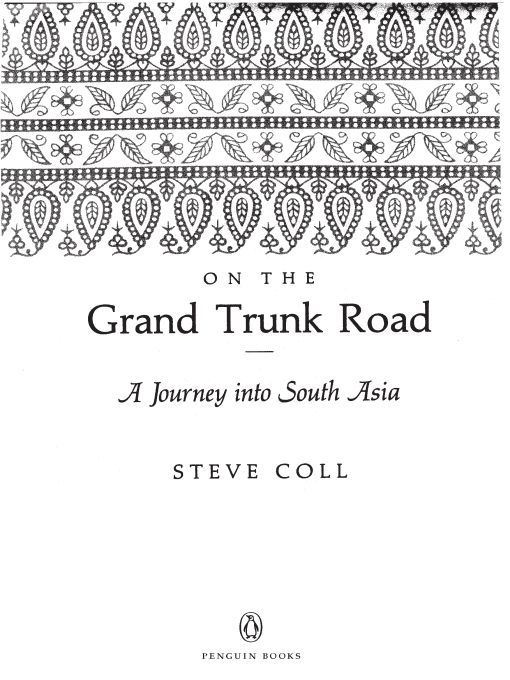Table of Contents
PENGUIN BOOKS
ON THE GRAND TRUNK ROAD
Steve Coll is most recently the author of the national bestseller The Bin Ladens. He is the president of the New America Foundation, a nonpartisan public policy institute headquartered in Washington, D.C., and a staff writer for The New Yorker. Previously he worked for twenty years at The Washington Post, where he received a Pulitzer Prize for explanatory journalism in 1990, traveled widely as a foreign correspondent, and served as the Posts managing editor between 1998 and 2004. He is the author of five previous books, including the Pulitzer Prize-winning bestseller Ghost Wars and The Taking of Getty Oil.
Introduction to the Paperback Edition
Between 1989 and 1992, when I served as a New Delhi-based foreign correspondent for the Washington Post and traveled to report the material in this book, I spent a great deal of time in Pakistan, often in the capital, Islamabad, an antiseptic planned city laid out on a grid. Almost invariably, I stayed at the Islamabad Holiday Inn, which later changed its affiliation to become the Islamabad Marriott Hotel. In that era of untroubled newspaper business models, I paid a little extra to book on the front-facing side of the fifth floor, where the rooms had vaulted ceilings and views of the Margala Hillssmall, morale-lifting advantages that eased the blues that come to those who live in a hotel room for weeks at a time. Downstairs, the lounges and restaurants were scenes of the sort of camaraderie peculiar to newspaper correspondents; here, the only palatable lubricant was bottled Murree Beer, which is officially available in Pakistans hotels to non-Muslim foreigners, provided they are willing to attest to their apostasy by signing their names in cloth-bound ledgers.
On a Saturday in mid-September 2008, a large truck arrived at the hotel. When security guards, alert to potential terrorist bombers, approached to inspect the truck, the driver detonated a cache of explosives stuffed into the hold. The blast excavated a crater thirty feet deep, blackened the facade of the hotel, and set the building on fire. Ultimately, more than four dozen people died and more than two hundred were injured. In New York, I watched televised reports of the attack; they showed, over and over, an image of tall flames that burned brightly in the hotels forward windows. It was like watching your college dormitory burn to the ground.
Pakistan has provided many such images of late; there is an air of violent transformation about the place, and an accumulating sense of loss. The country has survived many challenges and even cataclysms, including the severing of half of its territory in its 1971 war with India. If the past is any guide, the countrys resilient population and considerably less impressive politicians will muddle through the present crisesa vicious Islamist insurgency waged against the government by the Taliban and al Qaeda, compounded by accelerating inflation and economic stagnation. And yet it seems fair to ask what sort of guide the past may prove to be this time around. Pakistan may be passing into a particularly dark period, even by the measure of its own shadowed spectruma time for which there may be no entirely reliable maps.
When I wrote On the Grand Trunk Road more than fifteen years ago, I hoped to describethrough particular landscapes, stories, and peoplethe texture of a profound transition on the Indian subcontinent, one shaped by the Cold Wars end and the opening of a new era of political and economic possibility. It was a time of both unusual optimism and intense violence. I wrote that the specific reference points of debate about South Asias past and future are the instances of its sound and fury: its explosions. The themes are what this sound and fury signifies, where it arises from, and where it will lead. It is easy to ask many of the same questions today, particularly in Pakistan, Afghanistan, Sri Lanka, and Nepal. The subcontinent of 1992 would be familiar to todays traveler, if he or she could find a way to move about safelyAfghanistan is still crippled by war, much of it waged covertly and influenced by outside powers; Kashmir is still troubled by youthful Islamist insurgents; Sri Lanka is still gripped by extrajudicial killings, although on a lesser scale than before; Nepal is still searching for a plausible democratic constitution.
There has been one profound change from before, however: Indias rise as an economic power. Unshackled from its Nehruvian-socialist economic model, the country has birthed a new elite of conspicuous rich; a large, confident middle class with money to spend; and a media-soaked culture increasingly permissive about a style of conspicuous consumption that would astonish, and presumably pain, Mahatma Gandhi. There were glimmers of this possibility in 1992, but only that. Shining India, as the Hindu Nationalist political slogans today have it, is partly a miragepoverty, illiteracy, profound income inequality, and backward infrastructure remain embedded behind the glare. Even so, India today is a markedly more stable and prosperous country than it was when I moved there to work fifteen years agoand it is also the only country in South Asia of which that can be said.
If Indias success continues, in fifty years, the countrys more than one billion citizens may be transformed into a wealthy, innovative, and broadly prosperous society, much as the people of Korea and Japan were in the postwar period. A wealthy, democratic, pluralistic India could provide an important constitutional and even ethical anchor for the global politics of the twenty-first century. There is only one obvious strategic obstacle to Indias success: The potential failure of Pakistan, Indias ungainly colonial-era Islamic twin, an unruly sibling that has not grown up so well and bears considerable resentment about that fact.
Pakistans unhappy, incomplete search for identity and sustainable politics is not only Indias weighted anchor, of course; it is also, arguably, the most important foreign policy problem confronting the United States. This too marks a change from the early years after the Cold War. In those days, from the reactions of editors, Washington Post readers, relatives, and friends it was possible to conclude, sincerely if a little facetiously, as I wrote, that the United States tended to view South Asia as one billion riotous and unfathomable poor people best left alone, disarmed if possible. September 11, 2001, changed all that. American investments in Afghanistan and Pakistanin blood and treasure alikeseem likely to deepen and to remain laden with risk for another decade or more. Americas best-informed specialists on the region are no longer limited to the handful of foreign correspondents, spies, and diplomats assigned there by accidental rotation; they now also include hundreds of military officers who have served three tours attempting to quell the Taliban and cope with Pakistans tribal areas, work that looks more daunting by the month.
The Pakistan in these pages, thenthe culture of conspiracy, the problems of military rule, Islamist radicalism, and landed elitesremains, unfortunately, intact. So do many of the patterns of regional and guerrilla violence and environmental degradation, which the book attempts to describe. Because of the demands of journalism, my personal and emotional experience of South Asia has been too often connected with violence. Fifteen years ago, when I sat down to write, I began with this: During three years in South Asia, I shook hands with several men who subsequently exploded. There was no reason to suspect causality in this statistic. But the explosions were instants of intimate violence, and through their intimacy they demanded exploration. I can now extend that observation to be gender-inclusive. I was sitting in Londons Heathrow Airport in December 2007 when the first television bulletins reported that Benazir Bhutto had been assassinated by a suicide bomber who detonated himself beside her at the entrance to a park in Rawalpindi. To help connect the present with the past, I have added a new epilogue, Time Bomb, from work I recently completed for the


